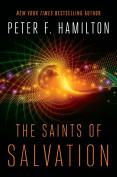Elderly astronomer “Augie” Augustine is stranded at an observatory in the Arctic after refusing to evacuate. The rest of the staff returned to civilisation amidst rumours of an unspecified global catastrophe. He finds a young, taciturn girl in one of the dormitories, and together they hunker down for the months-long arctic night.
The spaceship Aether has just left the Jovian system, on its way back to Earth. Mission control has mysteriously stopped transmitting, and communications specialist “Sully” Sullivan cannot reach anyone else. Tempers fray amongst the crew as the long transit continues, and it seems more and more likely that they may have nowhere to return to.
The novel is rather contemplative, lingering for long stretches on the mental states and tribulations of the two protagonists. Long flashbacks frame the narrative, as Augie and Sully delve into their pasts, subconsciously seeking to understand what brought them to where they are now. Strong themes of connection, relationships and human nature stand out as the situation grinds the characters down to the core of their personalities. Ms. Brooks-Dalton makes some bold narrative choices when it comes to the resolution, and this powerful novel comes out stronger for it.






























